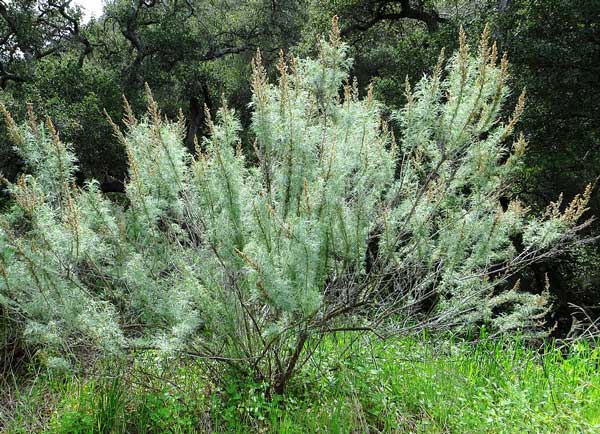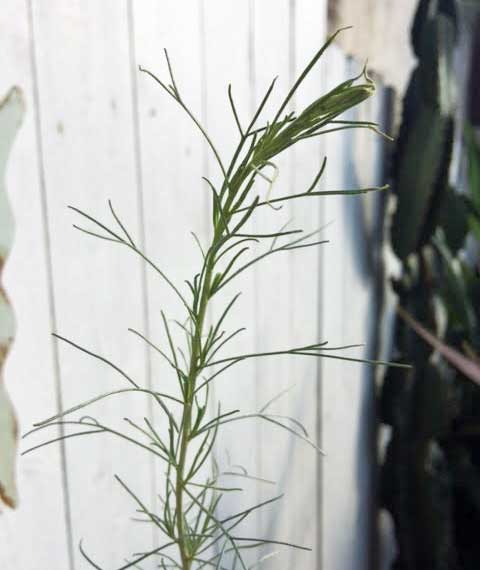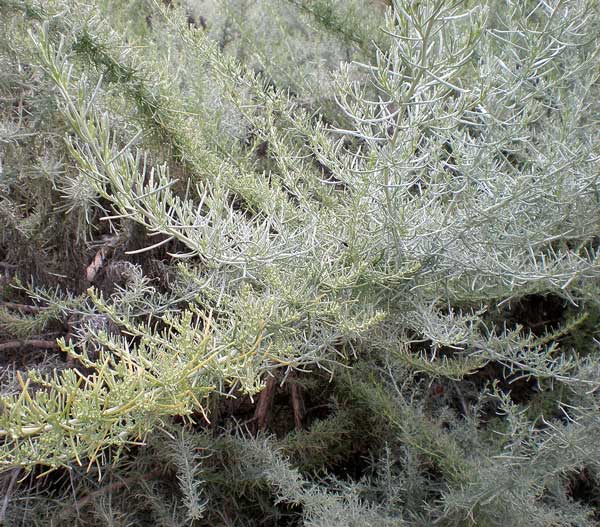Ethnobotany of southern California native plants:
California Sagebrush (Artemisia californica)
- author: Kevin Curran PhD
- published: February 5, 2016

photo credit: Antandrus at GFDL via Wikimedia Commons
California sagebrush after a spring rain.

A young shoot on a California sagebrush growing in my backyard.

credit: Consultaplantas, CC BY-SA 4.0 via Wikimedia Commons
California sagebrush foliage
California Sagebrush (Artemisia californica)
This is a well known, herbaceous plant from the Sunflower family (it’s not a true sage.)
California sagebrush is native to western California and Baja, Mexico. This plant is commonly seen in most of the plant regions of southern California (scrub, chaparral, alpine, desert valleys).
Artemisia plant uses
California sagebrush is considered one of the most medicinally useful plants. Its leaves were used for multiple health concerns, most notably as a natural remedy for colds. The Kumeyaay, from the San Diego region, dried out sagebrush leaves then prepared a tea from the foliage. This decoction was used to treat skin lesions. The tea was also drunk as a means to reduce fever symptoms.
The bitter leaves are antimicrobial in nature. For this reason – the fumes from a burning bundle of sagebrush leaves were considered to help clear out a respiratory tract infection.
The Cahuilla and Tongva people used California sagebrush as a gynecological aid. A decoction was used to ease menopause trauma. The plant was also administered at the beginning of a menstral period – and to ease the pains associated with childbirth. It is thought that the plant stimulates uterine mucosa, this activity would help expedite childbirth.
The Cahuilla people of the Coachella Valley region smoked the dried leaves of California sagebrush, for pleasure.
California Sagebrush (Artemisia californica)
So, what is contained within this plant that delivers these potential health benefits?
Scientists are beginning to explore this question.
If you prepare an extract from the plant you can begin to isolate some active chemicals.
We know there are two types of potent chemicals in this sagebrush: monoterpenoids and flavonoids.
In general, the flavonoids act as an anti-inflammatory while the monoterpenoids help relieve pain.
These monoterpenoids, like camphor and pinene, also contribute to the strong, sage-y aroma that emanates from this particular sagebrush.
Dr. James Adams at Univ. of Southern California has written this excellent paper about sagebrush chemistry.
Fifteen monoterpenes were discovered in A. californica: camphene, menthadiene, β- pinene, eucalyptol, isopropenylmethylcyclohexanol, trimethylheptadienol, isopropylmethylbicyclohexanol, thujanone, thujone, chrysanthenone, camphor, borneol, carene, menthenol, and menthadienol.
Fontaine, Pauline, et al. “Chemical composition and antinociceptive activity of California sagebrush (Artemisia californica).” J. Pharmacogn. Phytother 5.1 (2013): 1-11.
Sagebrush uses
Aside from medicinal properties, this sagebrush was also used as a construction material for homes. The plant was a popular material for roofing and the wattling of walls.
Granaries and storage facilities were often made from California sagebrush.
The strong scented foliage of this plant was laid out over perishable foods to help preserve them. Fresh berries and tubers would be covered with a layer of sagebrush branches. Clearly, the antimicrobial nature of the leaves lended well to keeping foods fresh and uncontaminated.
References:
Bean, Lowell John and Katherine Siva Saubel 1972 Temalpakh (From the Earth); Cahuilla Indian Knowledge and Usage of Plants. Banning, CA. Malki Museum Press (p. 42)
Bocek, Barbara R. 1984 Ethnobotany of Costanoan Indians, California, Based on Collections by John P. Harrington. Economic Botany 38(2):240-255 (p. 25)
Please return to our main Ethnobotany of southern California page.
On our main ethnobotany page, we present a clickable list of the southern California native plants that became a part of the culture of Native Americans and early European settlers. These plants were used for medicine, food, shelter, drink, tools and art.
Warning: The information about plants on this website is intended for general educational purposes only. The author of this website accepts no responsibility for problems arising from the user’s misidentification, misuse, or use of plants. Please read the full TERMS associated with this website.
